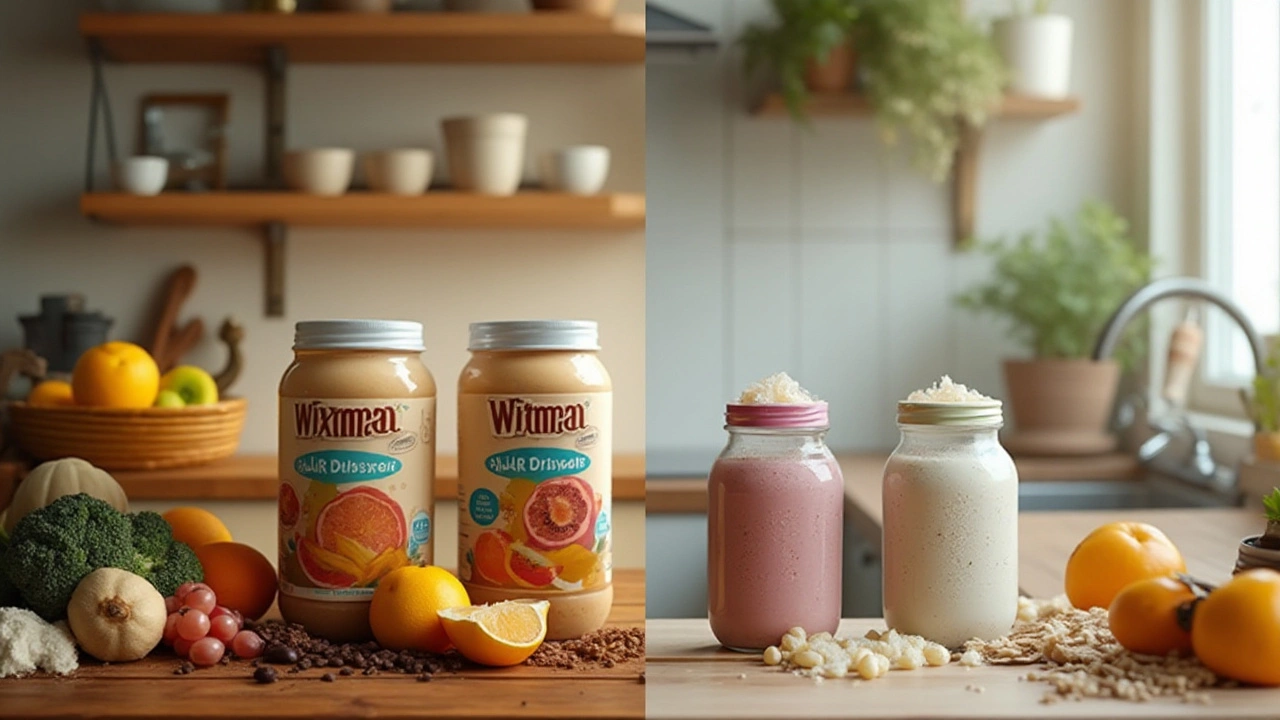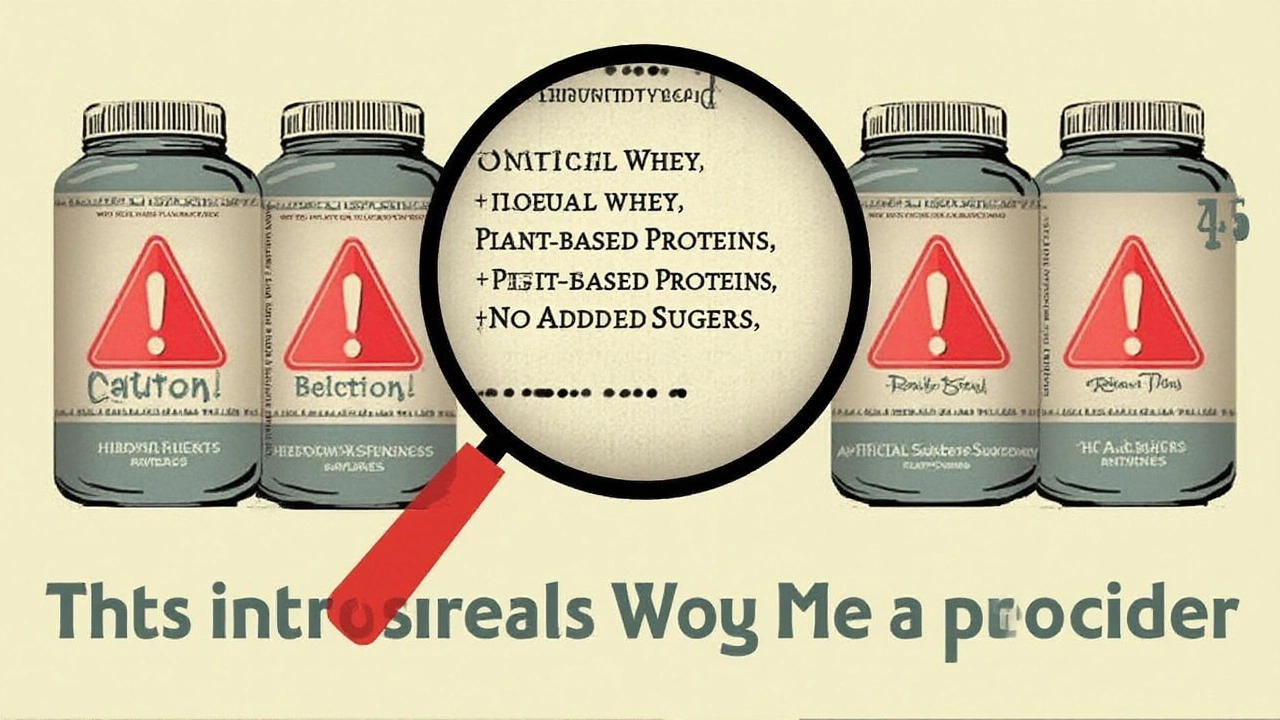
Protein shakes often top the list of go-to solutions for those looking to shed belly fat and build lean muscle. However, not all of these shakes are created equal. While some can work wonders for your waistline, others sneak in ingredients that derail your fitness goals.
Understandably, it’s easy to be wooed by the convenience and claims plastered on glossy labels. But beneath that enticing packaging could be a calorie-laden concoction that burdens your belly rather than banishing it.
In this article, we unveil the top offenders in the protein shake world. Not only will you discover what to avoid, but you'll also glean insights into making better choices. Your journey to a healthier and flatter stomach starts here—Say goodbye to unsuspected foes and hello to a trimmer you!
- Hidden Sugars and Sweeteners
- Low-Quality Protein Sources
- Excess Caloric Content
- Artificial Ingredients and Additives
Hidden Sugars and Sweeteners
One of the biggest misconceptions when it comes to protein shakes is the illusion of health that certain brands project. Many consumers don’t realize that behind the seemingly nutritious facade lies a cocktail of hidden sugars and sweeteners. These sugary villains are often listed as innocent-sounding ingredients like maltodextrin, fructose, or even agave syrup. In the grand scheme of nutrition, they can be as calorie-laden as a slice of cake, turning your supposedly healthy drink into an actual sugar bomb that fuels belly fat rather than fights it.
For instance, the average commercial protein shake can contain as much as 20-30 grams of sugar, which is nearly equivalent to the sugar content found in some soft drinks. The World Health Organization recommends keeping daily sugar intake to about 25 grams for adults seeking to maintain or lose weight. This means that a single serving might sneakily push you over your sugar limit before you’ve even sat down for breakfast. It’s vital to read labels carefully and understand that those endearing claims of all-natural ingredients shouldn’t cloud your judgment—or your waistline.
Syrups and Substitutes: A Deeper Dive
Artificial sweeteners such as sucralose and aspartame are often marketed as diet-friendly alternatives, yet studies have shown they can confuse your body's ability to regulate calories, potentially leading to increased cravings and weight gain. Even ‘natural’ sweeteners like honey or maple syrup aren’t free passes, as consuming them in excess can tip the scales out of your favor. It’s crucial to seek balance by combining your shake with whole foods that provide nutritional value without added sugars.
‘It's easy to be fooled into thinking all sugar substitutes are a harmless way to sweeten your protein shake,’ notes Dr. Samantha Cassetty, a renowned dietitian. ‘But in reality, they can be just as harmful as sugar itself if they're not managed wisely.’
A savvy approach involves selecting protein shakes with minimal added sugars and prioritizing those where the sweetness comes from whole foods. Be it a few fresh berries or a hint of vanilla, the natural sweetness from these simple ingredients is far kinder to weight loss efforts. As you navigate the nutritional landscape, keep an eye out for those crafty protein sources that say no to sneaky sugars and yes to supporting a healthier you.
Low-Quality Protein Sources
In the quest for slimming down, the choice of protein source is as crucial as the protein itself. Not all proteins are created equal, and low-quality options can stealthily sabotage your belly fat reduction efforts. Many inexpensive protein shakes use low-quality protein sources such as soy protein or non-organic whey, which often lack the essential amino acid profiles required for optimal body functioning and muscle repair. Soy protein, for example, while a popular plant-based option, may often be genetically modified and can sometimes lead to digestive concerns for sensitive individuals.
Non-organic whey is also a common culprit, potentially containing hormone residues or antibiotics from the cows used to produce the milk. The protein in these shakes is not only inferior in quality but sometimes sourced from cattle raised in less-than-ideal conditions. Over time, relying on such low-grade proteins could impact more than just your waistline. Your overall health and energy levels might suffer, as these poor protein sources do not provide the necessary sustenance your body craves.
The best way to keep your belly in check is to opt for shakes made with clean, high-quality protein sources like grass-fed whey or organic pea protein. These options have a rich content of branched-chain amino acids (BCAAs) that promote muscle growth and aid in faster recovery post-exercise. For those mindful of the entire nutritional package, selecting a protein shake with minimal extra ingredients can be crucial. As nutritionist Susan Fox once mentioned, "Fuel your body with premium protein sources and you'll notice the difference in your performance and physique."
Choosing wisely is about more than calories or taste—it's about understanding what your body needs and how to deliver it efficiently. Investing in a protein shake that offers support with every sip, rather than hindrance, ensures you stay on the right track. Consider labeling your shakes and noting their sources, so you can make informed decisions that align with your health and wellness goals. Whether it's for convenience or nutrition, always prioritize quality to optimize your path to a leaner you.

Excess Caloric Content
When it comes to slimming down and keeping belly fat at bay, managing caloric intake is pivotal. Many consumers turn to protein shakes as a convenient supplement to their daily routine, expecting them to offer a low-calorie, nutritious boost. Yet, the truth is some of these shakes are calorie bombs disguised in sheaths of health-focused branding. These shakes may contain more calories than you need in a snack or post-workout meal, quietly contributing to the very fat you're trying to lose.
Imagine shopping for a protein shake where the goal is a light snack, only to find your selection rivaling the calorie count of a hearty breakfast, sans the satisfaction. A typical fast-food breakfast might hover around 500-600 calories; surprisingly, some protein shakes can clock in right around this range due to copious amounts of sugar, additives, and even certain protein sources. This is particularly detrimental if they become a daily ritual, turning your healthy lifestyle intention into a calorie excess, prompting the accumulation of fat instead of its loss.
The root of this hidden caloric content often rests in the array of sweeteners and unrealistic serving sizes stated on packaging. For instance, a scoop may declare a manageable 150 calories, but a closer look at the small print might reveal this scoop is just a fraction of the recommended protein requirement for your dietary needs, subtly luring you to consume multiple scoops per serving. Consider the commonly overlooked fact that some of the top-selling protein shakes recommend a serving size of two scoops, doubling their advertised caloric content. Consequently, consumers inadvertently consume more than they bargained for.
Deceptive Packaging and Marketing Tactics
There is an undeniable art to the packaging that adorns protein shakes. Brand manufacturers have honed this to perfection, emphasizing not just muscle-building prowess but weight loss too, underplaying the caloric heft that lies beneath. Buzzwords like 'lean,' 'slim,' and 'diet' are splashed across labels, which are often coated with vibrant imagery designed to exude vitality and health. However, the seemingly inviting façade can obscure the caloric density within. As consumers, a vigilant approach is crucial when navigating these brands. The FDA allows for up to 20% leeway in calorie count discrepancies on labels; thus, what might appear as a minor underestimation can be a significant factor if consumed regularly.
According to Nutritionist Janet Helm, "We often see people falling into the trap of equating healthy with low-calorie, especially with protein shakes. It's always wise to flip the label and scrutinize the fine print."
Awareness is a powerful tool. Going beyond mere brand trust to a purposeful inquiry into what you are actually consuming is the key to controlling belly fat. Varied approaches such as homemade shakes can circumvent this issue entirely, giving you the power to tailor-make low-calorie, nutrient-rich shakes from scratch. Choosing simple ingredients like organic Greek yogurt, berries, and a spoonful of honey allows one to relish the guaranteed certainty of what goes into their belly.
Artificial Ingredients and Additives
In the quest for convenience, the lure of shiny, ready-to-grab protein shakes can be tempting. What many don’t realize is that these shakes often harbor an array of artificial ingredients and additives that can actually sabotage your efforts to lose belly fat. And that's only the start. Preservatives, fake flavors, and synthetic dyes are not just meaningless fillers, they're potential disruptors of your body’s chemistry. Many commercial shakes rely on artificial sweeteners to mimic the delightful taste of sugar, sans calories. But these sweeteners—I’m talking about sucralose, aspartame—while calorie-free, have been linked to increased cravings and overeating, throwing a wrench in your weight loss plans.
There’s also the issue of emulsifiers and thickeners like carrageenan and guar gum. Here’s something interesting: A study published by Georgia State University found these agents might disturb gut bacteria, which is essential for your metabolism. A trouble in your tummy neighborhood can ignite inflammation and, ironically, make fat loss around the belly difficult. So, while adding these ingredients might improve texture or shelf life, they do harm below the surface.
I once read an intriguing quote in a health journal which emphasized this point vividly:
"The stairway to a sprightly and lean physique starts with natural, whole foods—what you feed your gut, you feed your destiny."This spotlights that no magical ingredients in fancy formulations can replace the benefits of genuine nutrition. Even so-called "natural flavors" are not what they seem. Behind their simple moniker lurks a cocktail of hundreds of chemical concoctions that barely qualify as natural. As a consumer, you’re at a disadvantage, unable to unravel these intricacies without an advanced degree in chemistry.
So, what's a wiser choice? Start by scrutinizing those labels vigilantly. If it reads like a lab experiment, maybe it ought to stay on the shelf. Seek shakes with minimal ingredients, where you recognize and can actually pronounce the components. Keep a lookout for certified organic products, as they have stricter regulations regarding artificial content. When possible, try to blend your own shakes at home with protein shakes composed of clean, wholesome components like fruits, vegetables, and nut milk. A revolution can start at your kitchen counter, shaping a leaner waistline and healthier you.
